Many photographers look down their noses at pixel peeping but I find it useful in at least two situations.
Four days ago in the mountains I missed photographing some very interesting interactions between a couple of Gray Catbirds and an American Robin because I couldn’t quite shoot at that angle behind me from my pickup window. It was close so I tried but severe muscle cramps in my legs were the result (long story) so I had to abandon the attempt and just watch the exciting action I was unable to photograph.
It was highly frustrating.
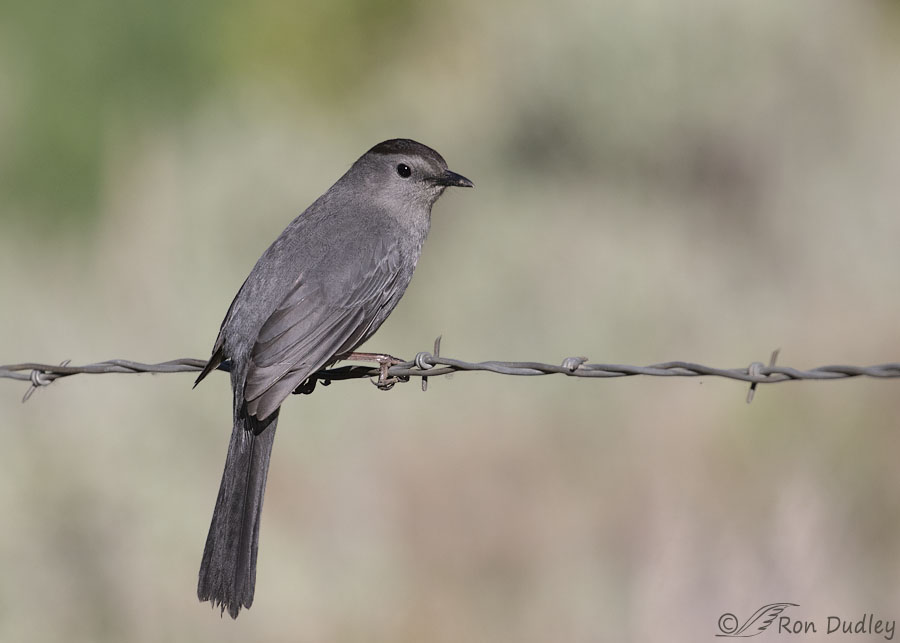
1/2500, f/7.1, ISO 800, Canon 7D Mark II, Canon EF 100-400mm f/4.5-5.6L IS II USM @ 400mm, not baited, set up or called in
One of the catbirds landing close to me on this barbed wire was my far from adequate consolation prize. ‘He’ was so close I couldn’t fit him comfortably in the frame so I switched to my smaller zoom lens for this and other similar shots.
But as I often do when a bird is close and I don’t like the perch or setting I decided to switch back to my big lens and take head shots. I’m a sucker for excellent detail in my photos, if for no other reason than to find out how sharp my photos really are and how well my lens is performing..
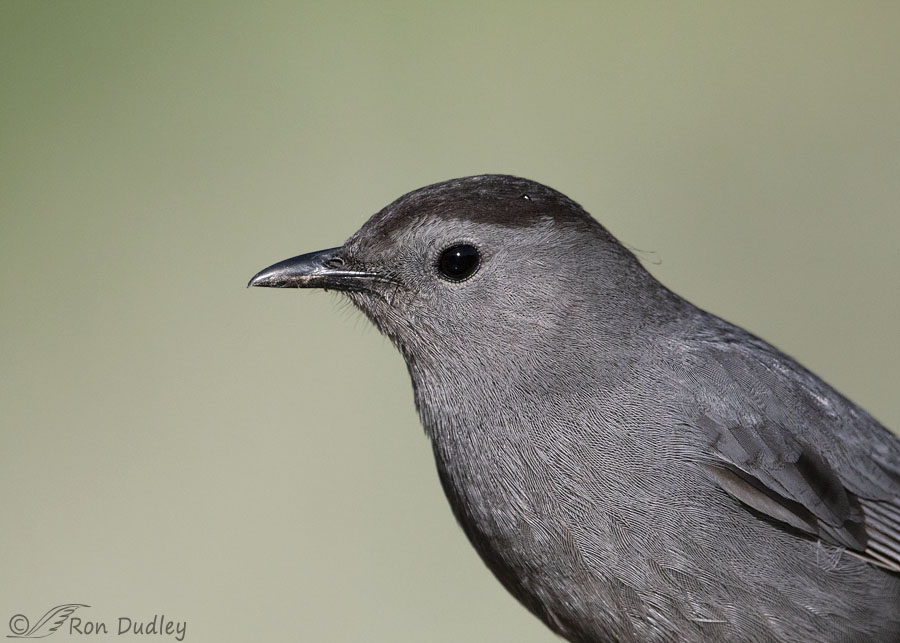
1/5000, f/6.3, ISO 800, Canon 7D Mark II, Canon EF 500mm f/4L IS II USM + EF 1.4 III Extender, not baited, set up or called in
This is one of the results, cropped to less than 50% of the original image. As a bird nut and a biologist I’m always interested in feather structure and function so as soon as I saw this version of the photo I wondered how much feather detail I’d be able to see if I cropped in even tighter.
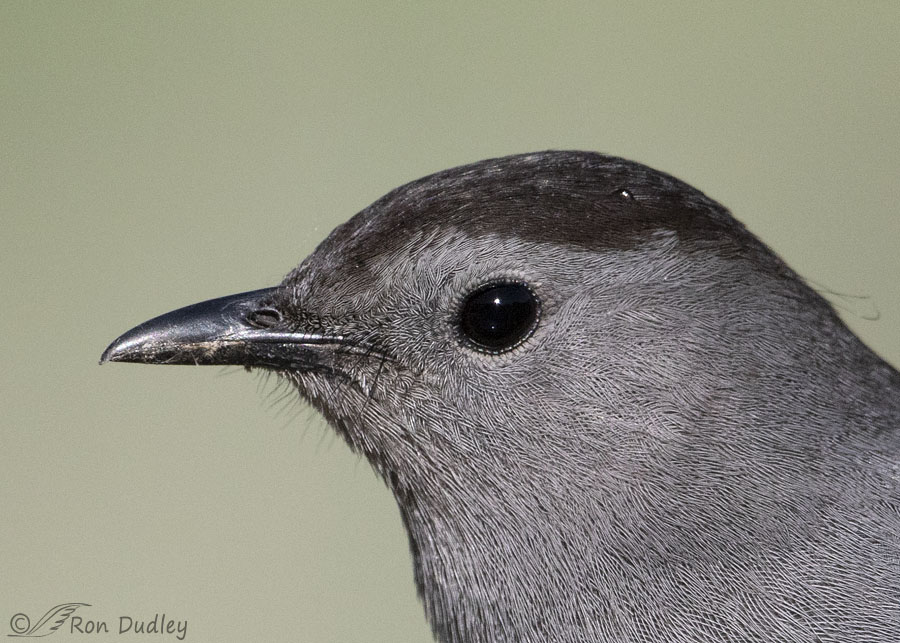
So I did, first on his head. I’m impressed by the feather detail and I enjoy actually seeing the rictal bristles at the base of his bill. And it isn’t often that we can see this much detail of the wear and tear on a wild bird’s utilitarian bill, despite the fact that the tip of his bill isn’t as sharp as the rest of his head.
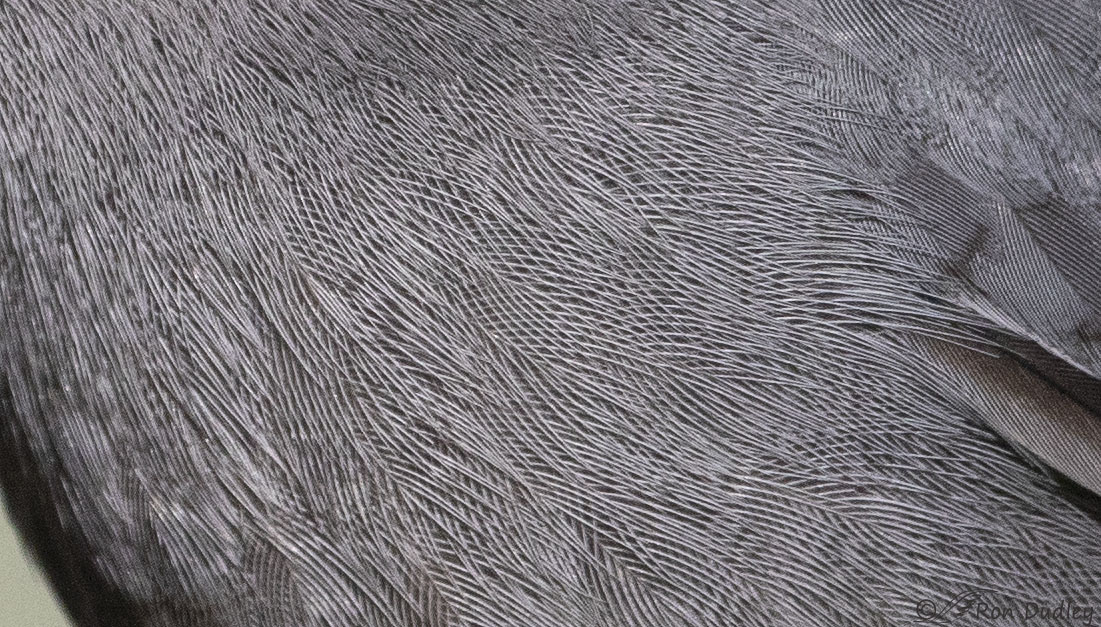
Even though his head is sharp it isn’t quite as sharp as some of his contour body feathers directly in front of the attachment of his left wing so I cropped in even tighter on that area in this version of the photo. This is actually what is defined as a ‘100% crop‘.
Here we can see why feathers are such good insulators. They trap air in countless small spaces to stop convection currents so the 106° F. body heat of birds is lost very slowly. There are many layers of these feathers, and air spaces, between the bird’s skin and the outside air so heat loss is kept to a minimum.
And when this photo was taken his feathers were held relatively flat against his body. When he fluffs his feathers in cold weather his insulating ‘R-value‘ is increased dramatically.
In digital photography pixel peeping is defined as “the process of viewing an image at 100% (or greater) in order to examine pixels in minute detail, ostensibly with the intent of looking for pixel level defects.” Often pixel peeping is thought of in a derogatory manner because images are normally never seen at such great magnification but as a bird lover and biologist I often find pixel peeping useful because it allows me to see interesting detail that I’d otherwise miss.
And I’ll admit it – I also like to pixel peep occasionally just to see if my lens is performing as well as it’s capable of. That brute was expensive and if it isn’t performing as it should I could do just as well with a much cheaper piece of glass.
I don’t think I’ll be downgrading anytime soon.
Ron
PS – At the last minute I decided to include a full frame (uncropped) version of the photo so readers could get a better perspective on how much I cropped the three previous versions of the image.
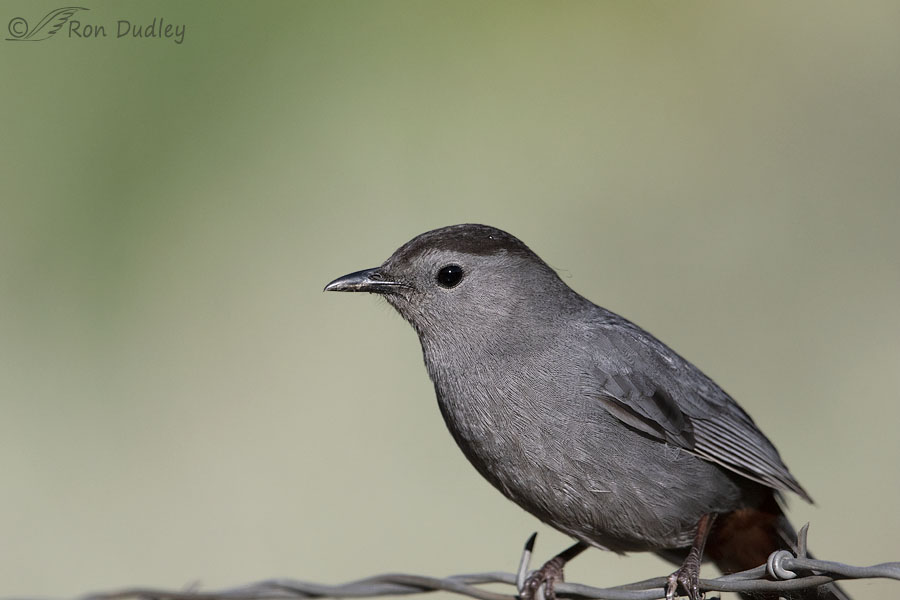


Thank you for defining pixel peep — would that make you a Peeping Ron?
I am fascinated by the closer and closer crops. Feathers are such amazing adaptations! Natural selection is so freakin’ cool!!! Woo Hoo! The subtle double catchlight is very attractive.
I totally get you on the spasm front. Mine tend to be in my front — usually abdominals or intercostals. It can feel like I’ve done 5000 sit-ups when they’re over. I also get them in my quads and hamstrings. I’d have to contort myself when I got them in the classroom — it made for some interesting teachable moments. Stupid fibro!
Peeping Ron here. Thankfully I didn’t get the spasms back when I was teaching. That would have made life in the classroom interesting to say the least.
Looks like you got a really nice long-range macro lens built into your telephoto.
The Gray Catbird’s head is awfully beautiful in spite of or perhaps because of its “earth tone” colors. All the books describe it as a black cap; seems more shades of brown to me.
Wonderful photos and post, as usual.
Thanks, Lyle. I actually use that lens for macro purposes sometimes.
Awe and wonder.
And huge thanks to Laura for the book recommendation.
I am all too familiar with those leg spasms. They wake me up shrieking regularly (so regularly that the shrieks don’t wake the other household residents).
Thanks, EC. Thankfully I get them at night a little less often now. It’s a helluva way to be awakened from a deep sleep isn’t it.
I usually enlarge your photos and look at feather detail. He has a different feather structure than most. I will discuss it with Haley when I see her today.
I pixel peep to look at sharpness too, my lens tends to have a sweet spot. I just need to remember to stay there instead of insisting on maximum telephoto length.
Leg cramps are no fun. I have to get up and walk around it it the only way I can stop them.
I thought you would be out in the field this beautiful morning. I would have but have a bird at that needs attention.
April, enlarging photos at the resolution I post them will provide little if any additional detail. It’s like looking at newsprint under a magnifying glass – the little dots get bigger but there’s no more detail.
I thought about going out but it was so darned cold (38° at my house) I thought it might keep the birds down in the early morning and besides there’s snow up high and I didn’t want to deal with it.
Besides, I’m involved with one of my projects – painting my storage shed.
You should have nice weather to paint now. It was cold this morning! I am going out to garden as soon as it warms up a bit in the shade.
38 was what it was here this morning w/snow still in the high country from a couple of days ago…… “Pushing it” for freezing!
Other “tasks” do call!
What wonderful detail! I never knew about those whiskers, or rictal bristles. I’ll agree with Everett and others that your lens appears to be doing its job. Feather sniffers unite!
“Feather sniffers unite!”
A new rallying cry! Thanks, Cathy.
Again, what Sallie Reynolds said! I’m fascinated by feathers, too! What an amazing adaptation!! And we’ve yet to be able to replicate the complexity of them when we borrow the idea for things like down jackets to keep us warm. The structure is just too intricate for our manufacturing processes.
Have you read Thor Hanson’s book, “Feathers, The Evolution of a Natural Miracle?” If you haven’t, let me recommend it HIGHLY! One of the things that shocked me reading his book is that the oil from the oil gland is NOT about water resistance. Instead, the water resistance comes from the tension between the feather structure and the weight of water drops (droplets). The oil(s) is about collecting the sun’s rays and transforming it into vitamin D to pair with calcium. And the intricacy of the feather structure is dependent on how much water/rain the feathers need to repel/resist. For example, Harris’ hawks don’t experience a lot of rain/water, so the structure of their feathers isn’t as dense as a redtail’s, whose feathers aren’t as dense as those of a duck. Just amazing! GADS but I love the wisdom of Nature!
And the whole structure idea doesn’t even touch the idea of the sheer BEAUTY!!
So I’ll join you as a pixel peeper. I’ll also admit that I’m a confirmed feather sniffer! I grab a sniff whenever possible and what a delightful smell. Makes me happy.
Thanks for the book recommendation, Laura. I haven’t read it but now I might.
A feather sniffer, huh. Folks might begin to wonder about you…
Ron, I know a lot of feather sniffers, including myself.
I prefer to leave all that feather dandruff and all those feather mites somewhere besides up my nose…
Mariah and Jack don’t have mites and only during the molt is there an issue with feather dandruff! I make sure of the mite issue–not my birds in this lifetime!! BTW, Mariah (female passage redtail hawk) smells Earthy/musky and Jack (male captive-bred Harris’ hawk) smells slightly spicy with a hint of musk. Both are utterly delightful! (Sorry, the word ‘musk’ escaped my memory this morning, otherwise I’d have included it in the original post.)
Thanks to Laura for recommending that wonderful Hanson book! There are so many enlightening bits. I also enjoy your exchanges with Laura on Red-tails. My favorite creatures. I have a non-releasable mal-imprinted and partially blind female RT – have lived with her for nearly 20 years. She is now 30, and beautiful and cantankerous as ever. Her smell is more spice than musk, cayenne, as a guess!
Okay – I’ve always wanted to fly. But now I see what I really want is feathers! Thanks, Ron.
Made me smile, Sallie.
Remarkable photography Ron. Good lesson on pixels and biology. Not being a photographer of your level I was not familiar with the expression “Pixel Peeping”, but now I understand. Those closeups with that magnification really allow you to see how the bird’s feathers work. And it appears that your very expensive glass is worth the price.
When you get the leg cramps do you need to get out and walk around?
“When you get the leg cramps do you need to get out and walk around?”
Everett, I do when I can but in this instance there was another photographer with me shooting the same birds. If I’d got out of my pickup I’d have scared the birds off so I just stayed in my pickup and cussed a blue streak…
I really admired the “100%” shot–even before reading your notation on the insulating efficiency of all those overlapping angles and airspaces, that’s
exactly what I could see –and it was beautiful, besides ! I, and several
members of my family , all have had ongoing problems with leg cramps,
and we’ve all found great relief with daily oral magnesium supplements–
just thought I’d mention it !
Thanks, Kris.
I take a daily multivitamin that includes magnesium. My cramps are related to nerve issues from my back problems.
Kris, I started having intense leg and back cramps, my doctor said one of my drugs was blocking magnesium and to add a magnesium supplement. It made a huge improvement.
Beautiful and instructive! Even got the “cat whiskers” They ARE subtly beautiful birds……… Leg cramps NOT amusing and definitely distracting….
They ARE subtly beautiful birds……… Leg cramps NOT amusing and definitely distracting…. 
On another note I’ve noticed the magpies really aren’t in the yard right now as they always are – wonder if the grackles ran them out?
Judy, one leg was was sore for two days after those cramps. It wasn’t worth it, even for those photos I missed which would likely have been wonderful.
Very nice analysis! I “pixel peep” my pics all of the time. Thanks for sharing the facts about the insulating factor of the feathers…very interesting.
Thank you, Rick. I think many photographers who make fun of pixel peepers do it themselves more often than they’ll admit.